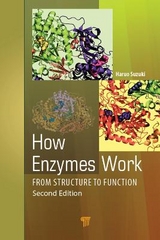
How Enzymes Work
Pan Stanford Publishing Pte Ltd (Verlag)
978-981-4463-92-8 (ISBN)
- Lieferbar
- Versandkostenfrei
- Auch auf Rechnung
- Artikel merken
Haruo Suzuki is professor emeritus at Kitasato University, Tokyo, Japan, a councilor of the Japanese Biochemical Society, and a member of the Japan Society for Bioscience Biotechnology and Agrochemistry. A biochemist, he graduated from the Department of Chemistry, Tokyo Metropolitan University, in 1966 and received his DSc from the Division of Biophysics and Biochemistry, the Graduate School of Science, University of Tokyo, in 1971. He worked as a postdoctoral fellow in the Department of Pathology, University of California at San Diego, from 1971 to 1973. He worked at the Institute for Developmental Research, Aichi Prefectural Colony, Japan, from 1973 to 1978, Kitasato University School of Medicine, Japan, from 1978 to 1994, and Kitasato University School of Science from 1994 to 2007. Prof. Suzuki’s research interests focus on the computer analysis (QM/MD) of enzyme catalysis.
Preface. Chapter One. Introduction. General properties of enzyme. Examples of enzyme. References. Chapter Two. Overall reaction kinetics. Road to the steady state kinetics. Demonstration of the enzyme-substrate complex. Meaning of steady state. Kinetic parameters. Problems. References. Chapter Three. Factors affecting on the enzyme activity. Enzyme. Substrate concentration. Inhibitor. Problems. References. Chapter Four. Effect of pH, temperature, and high pressure on the enzymatic activity. Effect of pH. Thermodynamics in the enzymatic reaction. Temperature dependence of the enzymatic reaction. Effect of pressure. Effect of temperature and pressure on α-chymotrypsin-catalyzed reaction. Problems. References. Chapter Five. Measurements of individual rate constants. Rapid mixing techniques. Analysis of the first-order reaction. Problems. References. Chapter Six. Structure of proteins. Amino Acids. Polypeptide and protein. Analysis of primary structure. Three dimensional structure. Tertiary and quaternary structures. Structural motif and loop. Problems. References. Chapter Seven. Active site structure. Active site and active center. Cofactor, coenzyme, prosthetic group. Search of active site. Examples of active site studies. Problems. References. Control of enzyme activity. Regulation by non-covalent interaction. Regulation by covalent Modification. Problems. References. Chapter Nine. Preparation of enzyme. Extraction of enzyme. Purification of enzyme. Purity analysis of enzyme. Problems. References. Chapter Ten. A case study: L-Phenylalanine ocidase (deaminating and decarboxylating). Introduction. Preparation of PAO. Catalytic properties of PAO. Molecular Properties of PAO. Physiological role of PAO. Problems. References. Appendix. Derivation of the rate equation by King-Altman’s method. Physical constants. Conversion of units. Greek numbers and alphabet. Useful softwares and data banks. Genetic code. Solutions for problems. Index.
| Zusatzinfo | 18 Illustrations, color; 105 Illustrations, black and white |
|---|---|
| Verlagsort | Singapore |
| Sprache | englisch |
| Maße | 152 x 229 mm |
| Gewicht | 453 g |
| Themenwelt | Medizin / Pharmazie ► Studium ► 1. Studienabschnitt (Vorklinik) |
| Naturwissenschaften ► Biologie ► Biochemie | |
| Naturwissenschaften ► Biologie ► Zellbiologie | |
| Naturwissenschaften ► Physik / Astronomie | |
| ISBN-10 | 981-4463-92-2 / 9814463922 |
| ISBN-13 | 978-981-4463-92-8 / 9789814463928 |
| Zustand | Neuware |
| Informationen gemäß Produktsicherheitsverordnung (GPSR) | |
| Haben Sie eine Frage zum Produkt? |
aus dem Bereich



